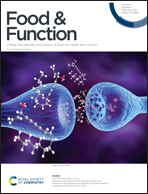Anti-Parkinson's disease activity of phenolic acids from Eucommia ulmoides Oliver leaf extracts and their autophagy activation mechanism†
Abstract
Although Parkinson's disease (PD) is the second most common neurodegenerative disorder, the preventative or therapeutic agents for the treatment of PD are limited. Eucommia ulmoides Oliver (EuO) is widely used as a traditional herb to treat various diseases. EuO bark extracts have been reported to possess anti-PD activity. Here, we investigated whether extracts of EuO leaves (EEuOL) also have therapeutic effects on PD since similar components and clinical applications have been found between barks and leaves of this tree. We identified the chemical composition of EEuOL by HPLC-Q-TOF-MS and tested the anti-PD effect of EEuOL using the zebrafish PD model. As a result, 28 compounds including 3 phenolic acids, 7 flavonoids, and 9 iridoids were identified. EEuOL significantly reversed the loss of dopaminergic neurons and neural vasculature and reduced the number of apoptotic cells in zebrafish brain in a concentration-dependent manner. Moreover, EEuOL relieved locomotor impairments in MPTP-modeled PD zebrafish. We also investigated the underlying mechanism and found that EEuOL may activate autophagy, contributing to α-synuclein degradation, therefore alleviating PD-like symptoms. Molecular docking simulation implied the interaction between autophagy regulators (Pink1, Beclin1, Ulk2, and Atg5) and phenolic acids of EEuOL, affirming the involvement of autophagy in EEuOL-exerted anti-PD action. The overall results indicated the anti-PD effect of EEuOL, opening the possibility to use the extract in PD treatment.



 Please wait while we load your content...
Please wait while we load your content...